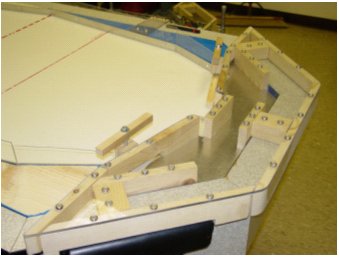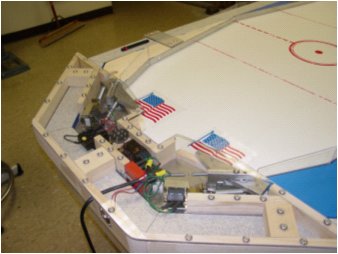MODIFICATION OF AN AIR HOCKEY TABLE FOR RECREATIONAL USE BY PEOPLE WITH DISABILITIES
ABSTRACT
An integral part of the educational experience is the opportunity to enjoy recreational time with other students. Many students are excluded from traditional recreational activities such as air hockey because of their severe physical disabilities. We have designed a modification to an existing air hockey game so that these students can play. With our design, the game is more accessible to a wide range of students and presents them an opportunity to participate in this fun and exciting game. By using a switch, they activate flippers that strike the puck, much like those in a pinball game.
BACKGROUND
The Rosedale School (1) is a member of the Austin Independent School District that serves the needs of students with severe physical, cognitive, and learning disabilities. Their goal is to engage the students in age-appropriate educational activities so that they may develop personal independence, strong relationships, and an improved self-esteem. An integral part to their educational opportunities is their recreational and leisure time. They purchased an air hockey table because they believed that it would be an exciting recreational opportunity for their students. Unfortunately, they discovered that the majority of their students do not possess the physical skills to play an air hockey game. The staff at Rosedale wants a modification made to the air hockey table that makes the game more inclusive so that the students with limited abilities can participate as well.
STATEMENT OF PROBLEM
There is no current technology available today that adapts air hockey for people with disabilities. The goal of our project is to design a modification to the existing air hockey table at Rosedale so that the students with limited abilities can play. With this modification, the final design should make the game more accessible to a wide range of students. However, we focused our attention on the students who function by using an electronic switch in their daily activities. Finally, we wanted to develop a product that could be easily installed, safe to play, and visually stimulating for the students.
DESIGN AND DEVELOPMENT
In order to arrive at our final product design, we followed an organized product design, development, and prototyping methodology (2). We performed several tasks for our design methodology: Task Clarification, Customer Needs Analysis, Functional Modeling, Concept Generation, Concept Selection, Embodiment, and Prototyping.
First, we conducted interviews with the Rosedale staff to clarify our problem so that we could have a clear set of customer needs. We spoke with several teachers and the recreational therapist to get a more lucid perspective of the design problem. From these customer needs, we established target specifications that we should strive to achieve with our final design in a House of Quality. We then developed a functional model of a modified air hockey game so that we could understand the driving functions in our design. Through several iterations of the functional model, we decided to focus on three principal functions: accelerating the puck, guiding the puck, and catching the puck.
These main functions guided the concept generation phase of the design process. We performed traditional brainstorming methods and also looked at analogous systems that we could use in our design. The main idea we cultivated involved a similar system to an air hockey game, a standard pinball game. This game utilizes a pair of flippers activated by the user input to the corresponding flipper switches. In addition, we performed a 6-3-5 visual brainstorming method so that we could generate creative ways to include the principal functions. The result was several concepts that we could consider for possible implementation. We chose to develop the flipper idea similar to the pinball setup with different methods of actuation. The first method we investigated was employing an air source that would accelerate the flippers forward. We built a proof of concept model and performed several calculations relating to the required airflow and power necessary to play the game. Unfortunately, we found that the air compressor needed to sustain a game would be too cost prohibitive to produce. The next method we pursued for actuating the flippers was implementing a standard solenoid that pulls back after receiving an electrical input. We constructed a pivoted flipper with a solenoid arm attached to the end of the flipper. This model fulfilled our customer needs more effectively, so we decided to incorporate the solenoid in our final design.
DESIGN EMBODIMENT
 |
 |
For our beta prototype (see Figures 1 and 2), we made several refinements to our design. We constructed two sets of manually operated flippers and two sets of solenoid-actuated flippers. For the flipper module, we constructed a Lexan top so that the inside components would be visible. In addition, we built an aluminum base plate so that the module would have a strong base of support. We also wanted to modify the guide rails by lining them with aluminum, which deflects the puck more effectively than wood. Next, we replaced the painters' tape with static cling sheets to stop the puck in front of the flippers. The tape left adhesive on the table, so we felt that a static cling would serve as a cleaner alternative. Another component we added to the final prototype is alerting the player when they have scored. At the rear of the goal area, we placed a roller switch that activates sounds when the puck strikes it. The sounds produce a more exciting game and provide a time for the staff to cheer for the students.
DISCUSSION AND CONCLUSION
Upon completion of the beta prototype, we presented the final design to the staff at Rosedale. They were overwhelmingly pleased with the modification we made to the air hockey game. They had not anticipated that we could design a device that would include the students with limited physical abilities in a game such as air hockey. An important aspect of our design that they especially appreciated was the cause and effect relationships the students could observe. They understood that by pressing the switch, they activated the flippers and hit the puck. They also recognized that by scoring a goal, a sound would signal their score. When the students played the gamed, their pleasure and enjoyment was readily apparent. Air hockey is an age appropriate game for the students at Rosedale, and we have been able to design a modification to the game so that almost all of them can participate. Since many of the students have limited opportunities for their recreational time, we are pleased we can offer them a new and exciting game that they can enjoy with their classmates.
ACKNOWLEDGEMENTS
We would like to offer our sincere thanks and gratitude to the staff and students at the Rosedale School for giving us a wonderful design project to pursue. We hope that our design can enhance the educational and recreational activities of their students in the future. We would also like to thank Dr. Kristin Wood and Dr. Richard Crawford for their continued guidance and support that they have provided during the course of our project. Finally, we wish to thank Andy Banks and the Faculty Innovation Center for assisting us in the production of our video presentation.
REFERENCES
-
Otto, Kevin N. & Wood, Kristin L. (2001). Product Design. Upper Saddle River, NJ: Prentice Hall.
